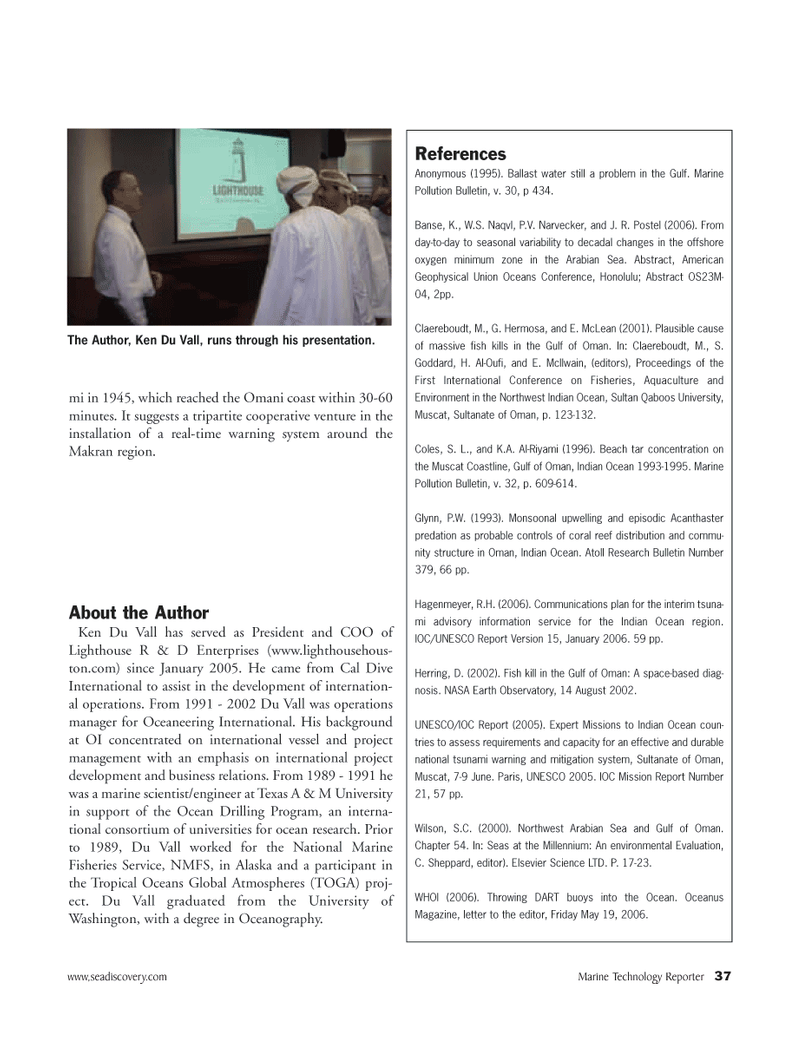
Page 37: of Marine Technology Magazine (January 2007)
Seafloor Engineering
Read this page in Pdf, Flash or Html5 edition of January 2007 Marine Technology Magazine
www,seadiscovery.com Marine Technology Reporter 37 mi in 1945, which reached the Omani coast within 30-60 minutes. It suggests a tripartite cooperative venture in the installation of a real-time warning system around the
Makran region.
About the Author
Ken Du Vall has served as President and COO of
Lighthouse R & D Enterprises (www.lighthousehous- ton.com) since January 2005. He came from Cal Dive
International to assist in the development of internation- al operations. From 1991 - 2002 Du Vall was operations manager for Oceaneering International. His background at OI concentrated on international vessel and project management with an emphasis on international project development and business relations. From 1989 - 1991 he was a marine scientist/engineer at Texas A & M University in support of the Ocean Drilling Program, an interna- tional consortium of universities for ocean research. Prior to 1989, Du Vall worked for the National Marine
Fisheries Service, NMFS, in Alaska and a participant in the Tropical Oceans Global Atmospheres (TOGA) proj- ect. Du Vall graduated from the University of
Washington, with a degree in Oceanography.
The Author, Ken Du Vall, runs through his presentation.
References
Anonymous (1995). Ballast water still a problem in the Gulf. Marine
Pollution Bulletin, v. 30, p 434.
Banse, K., W.S. Naqvl, P.V. Narvecker, and J. R. Postel (2006). From day-to-day to seasonal variability to decadal changes in the offshore oxygen minimum zone in the Arabian Sea. Abstract, American
Geophysical Union Oceans Conference, Honolulu; Abstract OS23M- 04, 2pp.
Claereboudt, M., G. Hermosa, and E. McLean (2001). Plausible cause of massive fish kills in the Gulf of Oman. In: Claereboudt, M., S.
Goddard, H. Al-Oufi, and E. McIlwain, (editors), Proceedings of the
First International Conference on Fisheries, Aquaculture and
Environment in the Northwest Indian Ocean, Sultan Qaboos University,
Muscat, Sultanate of Oman, p. 123-132.
Coles, S. L., and K.A. Al-Riyami (1996). Beach tar concentration on the Muscat Coastline, Gulf of Oman, Indian Ocean 1993-1995. Marine
Pollution Bulletin, v. 32, p. 609-614.
Glynn, P.W. (1993). Monsoonal upwelling and episodic Acanthaster predation as probable controls of coral reef distribution and commu- nity structure in Oman, Indian Ocean. Atoll Research Bulletin Number 379, 66 pp.
Hagenmeyer, R.H. (2006). Communications plan for the interim tsuna- mi advisory information service for the Indian Ocean region.
IOC/UNESCO Report Version 15, January 2006. 59 pp.
Herring, D. (2002). Fish kill in the Gulf of Oman: A space-based diag- nosis. NASA Earth Observatory, 14 August 2002.
UNESCO/IOC Report (2005). Expert Missions to Indian Ocean coun- tries to assess requirements and capacity for an effective and durable national tsunami warning and mitigation system, Sultanate of Oman,
Muscat, 7-9 June. Paris, UNESCO 2005. IOC Mission Report Number 21, 57 pp.
Wilson, S.C. (2000). Northwest Arabian Sea and Gulf of Oman.
Chapter 54. In: Seas at the Millennium: An environmental Evaluation,
C. Sheppard, editor). Elsevier Science LTD. P. 17-23.
WHOI (2006). Throwing DART buoys into the Ocean. Oceanus
Magazine, letter to the editor, Friday May 19, 2006.
MTR#1 (33-48).qxd 1/11/2007 4:14 PM Page 37

 36
36

 38
38
